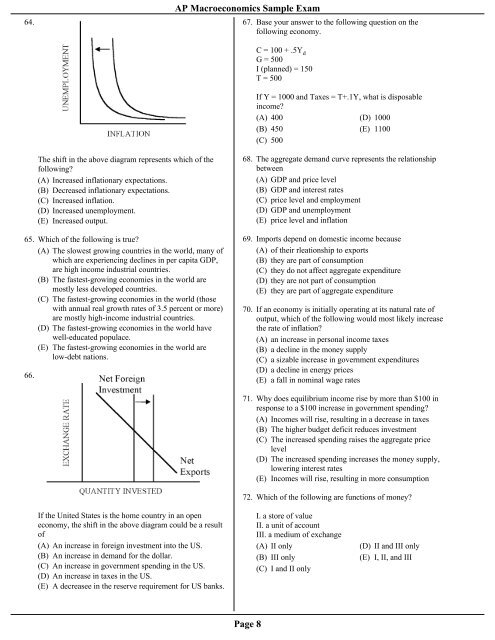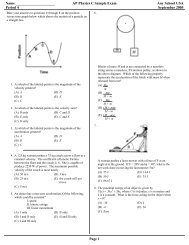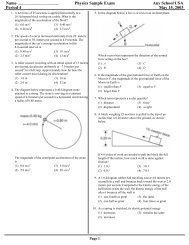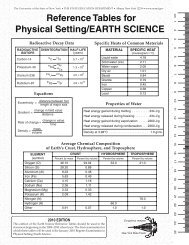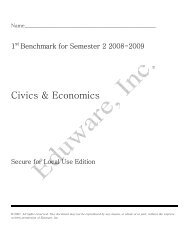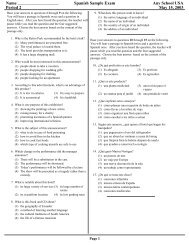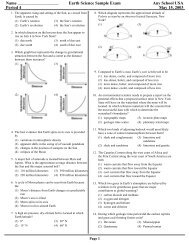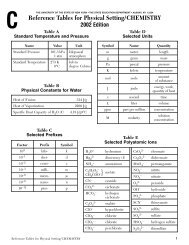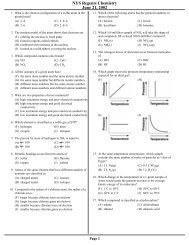The Wizard Test Maker - Eduware
The Wizard Test Maker - Eduware
The Wizard Test Maker - Eduware
Create successful ePaper yourself
Turn your PDF publications into a flip-book with our unique Google optimized e-Paper software.
64.<br />
AP Macroeconomics Sample Exam<br />
67. Base your answer to the following question on the<br />
following economy.<br />
C = 100 + .5Y d<br />
G = 500<br />
I (planned) = 150<br />
T = 500<br />
If Y = 1000 and Taxes = T+.1Y, what is disposable<br />
income<br />
(A) 400 (D) 1000<br />
(B) 450 (E) 1100<br />
(C) 500<br />
<strong>The</strong> shift in the above diagram represents which of the<br />
following<br />
(A) Increased inflationary expectations.<br />
(B) Decreased inflationary expectations.<br />
(C) Increased inflation.<br />
(D) Increased unemployment.<br />
(E) Increased output.<br />
65. Which of the following is true<br />
(A) <strong>The</strong> slowest growing countries in the world, many of<br />
which are experiencing declines in per capita GDP,<br />
are high income industrial countries.<br />
(B) <strong>The</strong> fastest-growing economies in the world are<br />
mostly less developed countries.<br />
(C) <strong>The</strong> fastest-growing economies in the world (those<br />
with annual real growth rates of 3.5 percent or more)<br />
are mostly high-income industrial countries.<br />
(D) <strong>The</strong> fastest-growing economies in the world have<br />
well-educated populace.<br />
(E) <strong>The</strong> fastest-growing economies in the world are<br />
low-debt nations.<br />
66.<br />
68. <strong>The</strong> aggregate demand curve represents the relationship<br />
between<br />
(A) GDP and price level<br />
(B) GDP and interest rates<br />
(C) price level and employment<br />
(D) GDP and unemployment<br />
(E) price level and inflation<br />
69. Imports depend on domestic income because<br />
(A) of their rleationship to exports<br />
(B) they are part of consumption<br />
(C) they do not affect aggregate expenditure<br />
(D) they are not part of consumption<br />
(E) they are part of aggregate expenditure<br />
70. If an economy is initially operating at its natural rate of<br />
output, which of the following would most likely increase<br />
the rate of inflation<br />
(A) an increase in personal income taxes<br />
(B) a decline in the money supply<br />
(C) a sizable increase in government expenditures<br />
(D) a decline in energy prices<br />
(E) a fall in nominal wage rates<br />
71. Why does equilibrium income rise by more than $100 in<br />
response to a $100 increase in government spending<br />
(A) Incomes will rise, resulting in a decrease in taxes<br />
(B) <strong>The</strong> higher budget deficit reduces investment<br />
(C) <strong>The</strong> increased spending raises the aggregate price<br />
level<br />
(D) <strong>The</strong> increased spending increases the money supply,<br />
lowering interest rates<br />
(E) Incomes will rise, resulting in more consumption<br />
72. Which of the following are functions of money<br />
If the United States is the home country in an open<br />
economy, the shift in the above diagram could be a result<br />
of<br />
(A) An increase in foreign investment into the US.<br />
(B) An increase in demand for the dollar.<br />
(C) An increase in government spending in the US.<br />
(D) An increase in taxes in the US.<br />
(E) A decreasee in the reserve requirement for US banks.<br />
I. a store of value<br />
II. a unit of account<br />
III. a medium of exchange<br />
(A) II only<br />
(B) III only<br />
(C) I and II only<br />
(D) II and III only<br />
(E) I, II, and III<br />
Page 8


